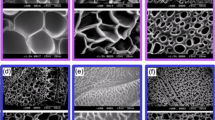Abstract
Cracks are one of the main problems in mortar and concrete leading to need of reparations and additional costs. One of the recent innovative solutions are superabsorbent polymers (SAPs). SAPs can swell up to several hundred times their own weight, can block the cracks and aid in healing them. Polysaccharides can offer a more sustainable alternative for synthetic SAPs. Functional monomers have been combined with cross-linkable methacrylated polysaccharides to incorporate them in the polysaccharide networks. These polymers have been chemically characterized in previous research by measuring among other their moisture and swelling capacity, where the pH-responsiveness leads to better control of these parameters. The current manuscript deals with the effect these polymers exhibit on the bending and compressive strength of mortar samples on the one hand and on the crack closure and self-healing of cracks on the other hand. The obtained results have been benchmarked with commercial SAPs and indicated that methacrylated alginate combined with acrylic acid, both with high as well as low degree of substitution gave rise to a strong self-healing capacity. They did induce a substantially lower effect on the compressive strength of mortars compared to commercial SAPs. Methacrylated chitosan combined with dimethylaminopropyl methacrylamide also gave very promising self-healing results, coming close to those of the best commercial SAP, although they induced a slightly more severe effect on the mortar strength than this commercial polymer.



Similar content being viewed by others
References
Edvardsen C (1999) Water permeability and autogenous healing of cracks in concrete. Mater J 96(4):448–454
Snoeck D, Dewanckele J, Cnudde V, De Belie N (2016) X-ray computed microtomography to study autogenous healing of cementitious materials promoted by superabsorbent polymers. Cem Concr Compos 65:83–93
Van Tittelboom K, De Belie N (2013) Self-healing in cementitious materials—a review. Materials 6(6):2182–2217
Yang Y, Lepech MD, Yang E-H, Li VC (2009) Autogenous healing of engineered cementitious composites under wet–dry cycles. Cem Concr Res 39(5):382–390
Snoeck D, De Belie N (2015) From straw in bricks to modern use of microfibres in cementitious composites for improved autogenous healing—a review. Constr Build Mater 95:774–787
Snoeck D, Steuperaert S, Van Tittelboom K, Dubruel P, De Belie N (2012) Visualization of water penetration in cementitious materials with superabsorbent polymers by means of neutron radiography. Cem Concr Res 42(8):1113–1121. https://doi.org/10.1016/j.cemconres.2012.05.005
Snoeck D, Van Tittelboom K, Steuperaert S, Dubruel P, De Belie N (2014) Self-healing cementitious materials by the combination of microfibres and superabsorbent polymers. J Intell Mater Syst Struct 25(1):13–24. https://doi.org/10.1177/1045389X12438623
Mignon A (2016) Effect of pH-responsive superabsorbent polymers on the self-sealing and self-healing of cracks in concrete. PhD, Ghent University
Mignon A, Snoeck D, D’Halluin K, Balcaen L, Vanhaecke F, Dubruel P, Van Vlierberghe S, De Belie N (2016) Alginate biopolymers: counteracting the impact of superabsorbent polymers on mortar strength. Constr Build Mater 110:169–174
Ji Y-s WuM, Ding B, Liu F, Gao F (2014) The experimental investigation of width of semi-carbonation zone in carbonated concrete. Constr Build Mater 65:67–75
Mignon A, Vermeulen J, Graulus G-J, Martins J, Dubruel P, De Belie N, Van Vlierberghe S (2017) Characterization of methacrylated alginate and acrylic monomers as versatile SAPs. Carbohydr Polym 168:44–51
Mignon A, Devisscher D, Vermeulen J, Vagenende M, Martins J, Dubruel P, De Belie N, Van Vlierberghe S (2017) Characterization of methacrylated polysaccharides in combination with amine-based monomers for application in mortar. Carbohydr Polym 168:173–181
Mignon A, Snoeck D, Schaubroeck D, Luickx N, Dubruel P, Van Vlierberghe S, De Belie N (2015) pH-responsive superabsorbent polymers: a pathway to self-healing of mortar. React Funct Polym 93:68–76
Snoeck D (2015) Self-healing and microstructure of cementitious materials with microfibres and superabsorbent polymers. PhD thesis, Ghent University
Snoeck D, Schaubroeck D, Dubruel P, De Belie N (2014) Effect of high amounts of superabsorbent polymers and additional water on the workability, microstructure and strength of mortars with a water-to-cement ratio of 0.50. Constr Build Mater 72:148–157
Snoeck D, De Belie N (2015) Repeated autogenous healing in strain-hardening cementitious composites by using superabsorbent polymers. J Mater Civ Eng 28(1):04015086
Snoeck D, Dubruel P, De Belie N (2014) How to seal and heal cracks in cementitious materials by using superabsorbent polymers. In: Proceedings of the international RILEM conference on application of superabsorbent polymers and other new admixtures in concrete construction, Sept 14–17, 2014, Dresden, Germany, pp 375–384. PRO 95
Yao Y, Zhu Y, Yang Y (2012) Incorporation superabsorbent polymer (SAP) particles as controlling pre-existing flaws to improve the performance of engineered cementitious composites (ECC). Constr Build Mater 28(1):139–145
Jensen OM, Hansen PF (2001) Water-entrained cement-based materials I. Principles and theoretical background. Cem Concr Res 31(4):647–654
Jensen OM, Hansen PF (2002) Water-entrained cement-based materials II. Experimental observations. Cem Concr Res 32(6):973–978
Hasholt MT, Jensen OM, Kovler K, Zhutovsky S (2012) Can superabsorbent polymers mitigate autogenous shrinkage of internally cured concrete without compromising the strength? Constr Build Mater 31:226–230
Mechtcherine V, Reinhardt H-W (2012) Application of super absorbent polymers (SAP) in concrete construction: state-of-the-art report prepared by Technical Committee 225-SAP, vol 2. Springer, New York
Acknowledgements
A. Mignon would like to thank the FWO (Research Foundation Flanders) for project funding (Grant No. 3G019012, Effect of tunable hydrogels on concrete microstructure, moisture properties, sealing and self-healing of cracks). Conflict of interest: as a Postdoctoral Research Fellow of the Research Foundation-Flanders (FWO-Vlaanderen), D. Snoeck would like to thank the foundation for the financial support (research Grant No. 12J3617N).
Author information
Authors and Affiliations
Corresponding author
Rights and permissions
About this article
Cite this article
Mignon, A., Vermeulen, J., Snoeck, D. et al. Mechanical and self-healing properties of cementitious materials with pH-responsive semi-synthetic superabsorbent polymers. Mater Struct 50, 238 (2017). https://doi.org/10.1617/s11527-017-1109-4
Received:
Accepted:
Published:
DOI: https://doi.org/10.1617/s11527-017-1109-4




